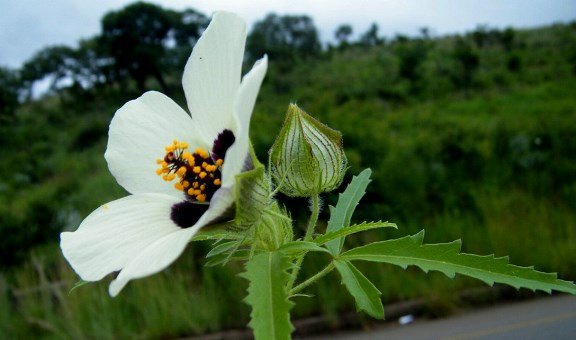Hibiscus trionum

Author: Ivan Lätti
Photographer: Piet Grobler
Hibiscus trionum is commonly known as flower-of-an-hour or bladderweed and in Afrikaans as Terblansbossie (little bush of Terblanche, a surname). (See H. pusillus also described in this Album for overlap in the common names.)
It is an erect to straggly, annual herb reaching heights from 20 cm to 60 cm, sometimes 1,5 m. The plant is an exotic established in South Africa, a weed with decorative qualities as well as a sparse covering of hairs that may irritate the skin. The stems are sometimes tinged purple.
The usually deeply three-lobed leaves are variable, sometimes further divided into side-lobes. Also the toothing along the lobe margins is variable. The lower surface of the leaf is paler than on top. Leaves vary in diameter from 2 cm to 6 cm.
The flowers grow solitary from leaf axils, sometimes hidden among the leaves. There is a bowl-shaped epicalyx below the flower, consisting of twelve narrow bracts, as well as a conspicuous calyx with prominent, longitudinal, purple veins and protruding margins.
The five spreading petals are pale cream, variable from nearly white to yellow and deep purple to red at the base where they form the floor of the corolla cup. The flower is up to 4 cm in diameter. Numerous yellow-anthered stamens emerge from the purple staminal column, erect in the flower centre.
The calyx inflates in fruiting, enclosing the fruit; hence the bladderweed name. Opening in the morning the flower closes by early afternoon, maybe making it the flower-of-an-hour. Flowering happens in summer.
This weed occurs widespread in the warmer parts of southern Africa, Europe, Asia and Australia, possibly originating from Europe. It is often found in grassland, disturbed places, ploughed and fallow fields.
In traditional medicine the plant is used in the treatment of internal parasites (Pooley, 1998; Van Wyk and Malan, 1997; Onderstall, 1996; iNaturalist).

